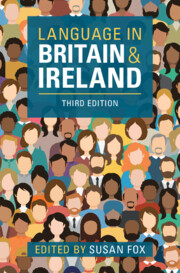Book contents
- Language in Britain and Ireland
- Language in Britain and Ireland
- Copyright page
- Contents
- Figures
- Tables
- Contributors
- Acknowledgements
- Map of Britain and Ireland
- Introduction
- Part I English
- 1 The History of English
- 2 Standard and Non-standard English
- 3 Phonetic and Phonological Variation in England
- 4 Grammatical Variation in England
- 5 Discourse-Pragmatic Variation in England
- 6 Scots and Scottish Standard English
- 7 English in Ireland
- 8 English in Wales
- 9 Insular Varieties of English in Britain
- 9 Insular Varieties of English in Britain
- 9 Insular Varieties of English in Britain
- 9 Insular Varieties of English in Britain
- Part II Multilingualism in Britain and Ireland: The Celtic Languages
- Part III Multilingualism in Britain and Ireland: Minority Languages
- Part IV Multilingualism: The Development of Urban Contact Varieties
- Part V Applied Sociolinguistic Issues
- Index
- References
9 - Insular Varieties of English in Britain
9.B The Isles of Scilly
from Part I - English
Published online by Cambridge University Press: 17 October 2024
- Language in Britain and Ireland
- Language in Britain and Ireland
- Copyright page
- Contents
- Figures
- Tables
- Contributors
- Acknowledgements
- Map of Britain and Ireland
- Introduction
- Part I English
- 1 The History of English
- 2 Standard and Non-standard English
- 3 Phonetic and Phonological Variation in England
- 4 Grammatical Variation in England
- 5 Discourse-Pragmatic Variation in England
- 6 Scots and Scottish Standard English
- 7 English in Ireland
- 8 English in Wales
- 9 Insular Varieties of English in Britain
- 9 Insular Varieties of English in Britain
- 9 Insular Varieties of English in Britain
- 9 Insular Varieties of English in Britain
- Part II Multilingualism in Britain and Ireland: The Celtic Languages
- Part III Multilingualism in Britain and Ireland: Minority Languages
- Part IV Multilingualism: The Development of Urban Contact Varieties
- Part V Applied Sociolinguistic Issues
- Index
- References
Summary
The Isles of Scilly are an archipelago twenty-eight miles off the south-west coast of England, with a population of c. 2,000 people. The current indigenous population is believed to have descended from 1571, when the islands were repopulated by a member of the aristocracy who leased the islands from the British Crown. The islands’ leasing continued until 1920, when all but one island reverted to the Duchy of Cornwall. Metalinguistic commentary from the sixteenth century onwards suggests that Scillonians are perceived as more cultured, better educated and better spoken than their mainland counterparts. By drawing on oral history data, this vignette will explore the accuracy of these perceptions. To do so, it examines the extent to which phonetic features of Scillonian English relate to traditional varieties of Cornish English, on the one hand, and standard English, on the other. In explaining the patterns of linguistic variation found on the islands, consideration is given to the presence (or not) of the Cornish language on the islands, dialect contact, the ‘feudal-like’ system of governance, the peculiarities of education practices, and the identity factors that affect how and why different groups of Scillonians use distinctive linguistic variants.
Keywords
- Type
- Chapter
- Information
- Language in Britain and Ireland , pp. 238 - 248Publisher: Cambridge University PressPrint publication year: 2024

